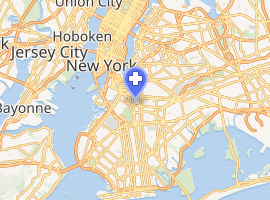Brooklyn Jewish Hospital and Medical Center
The Brooklyn Jewish Hospital and Medical Center was an academic, sectarian hospital in Crown Heights and Prospect Heights in Central Brooklyn. It merged with St. John's Episcopal Hospital to form Interfaith Medical Center in 1983.[1]
| Brooklyn Jewish Hospital and Medical Center | |
|---|---|

| |
| Geography | |
| Location | 555 Prospect Place, Brooklyn, New York, United States |
| Coordinates | 40°40′32″N 73°57′30″W |
| Services | |
| Beds | 886 beds |
| History | |
| Opened | 1906 |
| Closed | 1983 |
| Links | |
| Lists | Hospitals in New York |
History
The hospital's predecessor was the Brooklyn Hebrew Hospital Society, formed in 1895 as a clinic. In the early 20th century, many Jewish communities saw both benefit and need in developing modern hospital facilities.[2] By 1901, local community leaders saw the need to expand the Society to a 50-bed hospital, and by 1903, had purchased an older hospital campus, the Memorial Hospital for Women and Children, to renovate and reopen. It was located on the block of Classon Avenue, between Prospect Place and St. Marks Avenue. Shortly after its purchase, the trustees decided that the community could support a much larger facility and spent several years fundraising, insisting that work not start until money was in hand to cover all the work.[3] This combination of expansive plans and fiscal conservatism delayed the opening by several years.[2] In 1906, as fundraising and construction continued, additional property was purchased along St Marks Avenue, and later that year, an additional adjacent tract was acquired. The additional space was used for a nursing school and dormitory, and administrative offices. The hospital opened to patients on December 17, 1906. The nursing school had opened earlier in the month, on December 4.
In the 1920s, Nathan Jonas donated additional land to the hospital for a park, but it was later used to build a new wing, which opened in 1928, giving the hospital a 650-bed capacity. Jonas, a founder of the hospital, raised much of its funding from Abraham Abraham, a founder of the Abraham & Straus department store.[2]
In the 1930s, the hospital's president, Joseph Baker, was also the chair of the nearby Long Island College Hospital.
While the hospital thrived for about 50 years after its opening and continued to expand further along and across Prospect Place, it ran into financial trouble as the neighborhood declined. Short on money, the physical plant and equipment was neglected. Jewish Hospital was forced into bankruptcy, reorganized, and eventually merged with St. John's, another struggling hospital.[1][4]
After the merger, most of the campus, including the original main building along Classon Avenue, was sold off and converted to apartment buildings. The masonry facade on Classon still bears the name of the hospital. A building on Prospect Place continues to serve as an outpatient clinic of the surviving organization. The elimination of the legacy Jewish Hospital after the merger has been cited as an example of the issues facing mergers of struggling partner hospitals and of the difficulties of merging dissimilar sectarian cultures.[2]
References
- Sullivan, Ronald (1982-12-17). "Hospitals Merge, Joining 2 Faiths in Deprived Area". NYTimes.com. Retrieved 2015-11-14.
- Kraut, Alan M.; Kraut, Deborah (2006-12-20). Covenant of Care: Newark Beth Israel and the Jewish Hospital in America. Rutgers University Press. pp. 5, 97, 213–214. ISBN 9780813542393.
- Abelow, Samuel Philip (1937). History of Brooklyn Jewry. Scheba publishing Company. pp. 5, 25, 64, 197–213.
- French, Howard W. (1989-03-20). "In Brooklyn, a Hospital Faces Its Own Mortality". The New York Times. ISSN 0362-4331. Retrieved 2017-08-31.